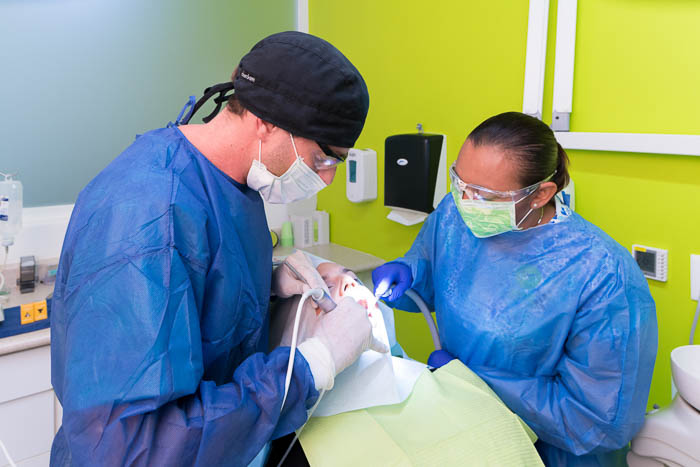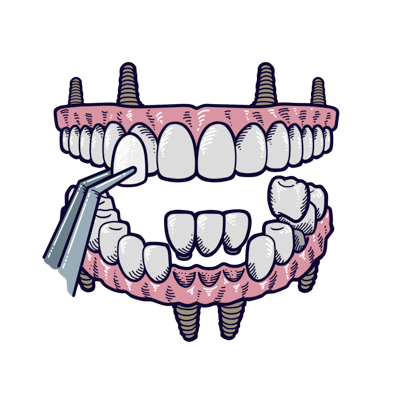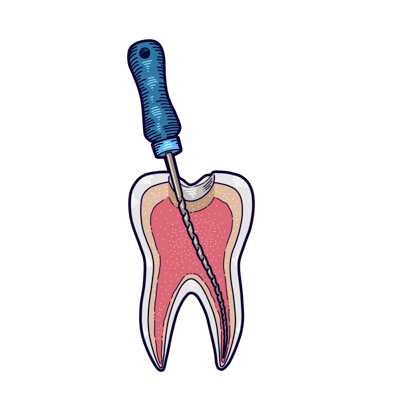Price of
3 ON 6
DENTAL IMPLANTS
IN MEXICO

Try our Cost & Smile Simulator
from the comfort of your own home.
100% Free. 100% Confidential.


What Are 3 on 6 Dental Implants?
The 3 on 6 dental implant system is a cutting-edge solution for full-arch rehabilitation. This advanced technique involves the placement of six dental implants per arch, which are used to support three independent bridges. Each bridge is attached to two implants, providing a strong and stable foundation that mimics the natural spacing and functionality of individual teeth.
This method differs from conventional All on 4 and All on 6 systems, which utilize a single full-arch prosthesis supported by four or six implants, respectively. Instead, 3 on 6 replicates the structure of a natural mouth more closely, offering enhanced aesthetics and improved oral hygiene due to the separation between the bridges.
What is the Difference Between 3 on 6 and
All on 4 Implants?
- Number of Prosthetic Bridges:
- 3 on 6: Utilizes three separate bridges per arch. Each bridge is individually attached to its own set of implants, making the replacement feel closer to natural teeth.
- All on 4: Consists of a single prosthetic bridge that spans the entire arch, covering all four implants. The prosthesis is typically larger and may feel bulkier.
- Implant Distribution:
- 3 on 6: Employs six implants evenly distributed across the jawbone. This provides a more balanced support structure for each bridge, reducing the load on individual implants.
- All on 4: Features only four implants, often angled to maximize bone use, especially in patients with lower bone density. This approach minimizes the need for bone grafting but places more stress on fewer implants.
- Aesthetic and Functional Differences:
- 3 on 6: Offers a more natural look and feel due to its segmented structure. Patients find the separation between the bridges provides a sensation similar to having natural teeth.
- All on 4: Can appear bulkier, as the entire arch is replaced with one continuous bridge, potentially affecting speech and comfort in some patients.
- Maintenance and Hygiene:
- 3 on 6: Easier to clean, as the three bridges allow for better access between segments, similar to cleaning natural teeth.
- All on 4: Requires cleaning around a single, large prosthesis, which can make thorough hygiene challenging.
Which Option is Better for Full Mouth Restoration:
3 on 6 or All on 4?

The decision between 3 on 6 and All on 4 implants depends on several factors, including bone availability, aesthetic goals, and patient preferences. Patients who prioritize a natural feel and improved hygiene often prefer the 3 on 6 system. However, All on 4 can be ideal for those with lower bone density or those looking for a quicker, less invasive solution.
Clinically, the 3 on 6 system may provide superior longevity and reduced maintenance costs over time, but it also involves a more complex and time-intensive procedure compared to the streamlined All on 4. Consulting with a dental implant specialist can help determine the best approach based on individual needs and oral health.
What Are the Benefits of 3 on 6
Dental Implants?

The 3 on 6 system offers numerous advantages, especially for patients considering a more permanent and natural-feeling solution. Key benefits include:
- Enhanced Oral Hygiene: With three separate bridges, patients can maintain oral hygiene similar to caring for natural teeth. This significantly reduces the risk of peri-implantitis, a common issue with full-arch prostheses.
- Durability and Stability: The six implants distribute biting forces evenly, reducing stress on any single implant and enhancing the lifespan of both the implants and the prosthetics.
- Natural Feel and Functionality: Each bridge is designed to mimic the natural structure and spacing of teeth, providing a more realistic bite and feel compared to the unified prosthesis used in the All on 4.
- Ease of Maintenance: In the event of a repair or replacement, only the affected bridge needs attention, leaving the rest of the arch intact. This contrasts with All on 4, where issues typically require the removal of the entire prosthesis.
Why Choose Mexico for 3 on 6
Dental Implants?
Mexico has become a leading destination for advanced dental implant procedures, including the 3 on 6 system, due to the following factors:
Price Savings
Up to 60% lower than in the USA or Canada.
Experienced Implant Specialists
Clinics in Mexico often have highly skilled professionals who are well-versed in the nuances of both 3 on 6 and All on 4 systems.
State-of-the-Art Facilities
Many clinics feature modern technology, digital planning systems, and internationally accredited standards.
Accessibility
Proximity to North America, combined with affordable travel options, makes it convenient for patients.


Try our online Cost & Smile Simulator from the comfort of your own home.
100% Free. 100% Confidential.
Price of 3 on 6 Dental Implants in Mexico
Patients can expect the following prices for 3 on 6 dental implants in Mexico:
- 3 on 6 with Acrylic Bridges: $8,000 USD to $10,000 USD per arch.
- 3 on 6 with Zirconia Bridges: $10,000 USD to $12,000 USD per arch.
These prices are significantly lower than those in the USA or Canada, where the same procedures can cost upwards of $35,000 USD to $45,000 USD per arch.
Comparing Prices: 3 on 6 in Mexico vs.
USA and Canada
Patients often find that choosing Mexico for their dental implant procedure can lead to substantial savings without compromising on quality. Here’s a detailed comparison of the average prices for 3 on 6 implants in Mexico versus the USA and Canada:
| Procedure | Mexico | USA | Canada |
|---|---|---|---|
| 3 on 6 with Acrylic Bridges | $9,000 USD | $35,000 USD | $38,000 USD |
| 3 on 6 with Zirconia Bridges | $12,000 USD | $45,000 USD | $48,000 USD |
Choosing Mexico can result in savings of over 60% per arch, making high-quality dental care more accessible. However, these prices can vary depending on individual patient needs, bone density, and additional procedures such as bone grafting or sinus lifts.
3 on 6 vs. All on 4: Pros and Cons
Pros of the 3 on 6 System:
- Improved Stability: Six implants provide a more stable base, evenly distributing the biting forces across the jaw.
Natural Aesthetics: The segmented structure mimics the look and feel of natural teeth. - Better Oral Hygiene: Spaces between the three bridges allow for easier cleaning and flossing.
Reduced Maintenance Costs: If one bridge is damaged, only that segment needs replacement, rather than the entire prosthesis. - Enhanced Longevity: Patients often experience longer-lasting results due to the even distribution of pressure and forces on the implants.
Cons of the 3 on 6 System:
- Higher Initial Price: Because of the additional implants and individualized prosthetic bridges, the initial price can be higher than that of the All on 4.
- More Complex Procedure: Requires a longer surgical time and healing period due to the greater number of implants and precision needed.
- Longer Healing and Recovery: The six implants require careful osseointegration, which can extend the healing process.
Pros of the All on 4 System:
- Minimally Invasive: With only four implants, the procedure is less invasive and can be completed in a shorter timeframe.
- Lower Initial Price: Fewer implants mean lower surgical and prosthetic prices upfront.
Quicker Recovery Time: The streamlined approach typically allows for faster healing and quicker placement of the final prosthesis. - Ideal for Low Bone Density: Because the implants can be angled to maximize bone contact, All on 4 is often suitable for patients with low bone density, reducing the need for bone grafting.
Cons of the All on 4 System:
- Higher Initial Price: Because of the additional implants and individualized prosthetic bridges, the initial price can be higher than that of the All on 4.
- More Complex Procedure: Requires a longer surgical time and healing period due to the greater number of implants and precision needed.
- Longer Healing and Recovery: The six implants require careful osseointegration, which can extend the healing process.
The 3 on 6 Implant Procedure Explained
The first step involves a comprehensive evaluation of the patient’s oral health. During this phase, the dental professional will:
- Perform a thorough examination to evaluate the condition of the gums and any remaining teeth.
- Use advanced imaging techniques, such as panoramic X-rays and 3D cone-beam CT scans, to assess bone density and jaw structure.
- Determine if additional procedures, such as bone grafting, will be required.
- Discuss the patient’s treatment goals, aesthetic preferences, and long-term expectations.
This stage is crucial to creating a customized treatment plan, which will outline each step of the process, from initial surgery to final prosthesis placement.
- Extraction of Remaining Teeth: Any damaged or decayed teeth are removed to create a clean foundation.
- Bone Grafting (if required): If the patient lacks sufficient bone density to support the implants, bone grafting may be performed to augment the jaw. This procedure can add 3-6 months to the total treatment time. 5
- Treatment of Gum Disease: Any existing periodontal issues must be addressed to prevent complications during the implant procedure.
The surgery itself involves the following steps:
- Anesthesia Administration: Local or general anesthesia is administered based on patient preference and the complexity of the case.
- Strategic Placement of Six Implants: Six titanium implants are placed at precise locations in the jawbone to provide maximum support and stability. These implants are typically placed in a straight or slightly angled orientation to avoid anatomical structures like the sinuses.
- Use of Healing Caps: Temporary healing caps are placed over each implant to protect them during the osseointegration process, where the implants fuse with the surrounding bone.
The healing period is a critical phase that can last between 3 to 6 months. During this time:
- The implants gradually fuse with the bone through a process known as osseointegration, which ensures a solid and stable foundation for the bridges.
- Regular follow-up appointments are scheduled to monitor healing progress and make any necessary adjustments.
- Patients are often provided with temporary dentures to maintain aesthetics and function during the healing period.
Once the implants have fully integrated, the final step involves the placement of the permanent prosthetic bridges:
- Creation of Custom Bridges: Each bridge is custom-designed using either porcelain or zirconia to match the patient's natural teeth in color, shape, and size.
- Attachment of Bridges: Each of the three bridges is attached to two implants, ensuring a precise fit and optimal function.
- Final Adjustments: Minor adjustments are made to ensure comfort, proper bite alignment, and aesthetics.
This step restores the patient’s full oral functionality and aesthetic appearance, providing a permanent solution that feels and looks natural.

Frequently Asked Questions
What makes 3 on 6 implants different from All on 4 implants?
The 3 on 6 system uses six implants to support three separate bridges, offering a more natural feel, improved hygiene, and greater durability. In contrast, All on 4 utilizes four implants to support a single full-arch prosthesis, making it a simpler and often more affordable option, but one that may not provide the same natural sensation and flexibility.
Who is a good candidate for 3 on 6 dental implants?
Ideal candidates are individuals missing most or all teeth in an arch, have sufficient bone density, and are in good overall health. Patients who prioritize a more natural feel, better oral hygiene, and a durable long-term solution may benefit more from the 3 on 6 system.
How long does the entire 3 on 6 process take?
The surgical placement of implants can be completed in one day per arch. However, the entire process, including healing and final bridge placement, usually spans several months, depending on the patient’s healing speed and whether additional procedures such as bone grafting are needed.
What materials are used for the bridges in 3 on 6 implants?
Bridges are typically made from high-quality porcelain or zirconia. Porcelain offers a natural look and is ideal for aesthetics, while zirconia provides exceptional strength and durability, making it suitable for patients who require a more robust solution.
Tips for Travelling to Mexico
for Dental Work

- Research Reputable Clinics: Look for certifications, patient reviews, and before-and-after photos to ensure the quality of care.
- Consultation: Consider online consultations to discuss your needs before traveling.
- Travel Logistics: Book flights to cities like Tijuana or Cancun, which have convenient access to major dental tourism clinics.
- Prepare Your Health Records: Bring a full medical and dental history to facilitate treatment planning.

Conclusion
The 3 on 6 dental implant system offers a sophisticated solution for full-mouth restoration, providing enhanced aesthetics, functionality, and longevity compared to traditional All on 4 systems. With a detailed treatment plan, skilled professionals, and modern facilities, SOTA Dental helps patients access world-class dental care at a fraction of the price in the USA and Canada.
References
- PubMed: Smoking and dental implants – PMC
- ITI: Timing of Implant Placement after Tooth Extraction – Learning Modules – Home – ITI
- AAID: Frequently Asked Questions – The Dental Implant Experts – AAID-Credentialed Dentists
- ADA: Bridges, implants, and dentures – The Journal of the American Dental Association
- Springer Nature Link: Effect of bone quality and quantity on the primary stability of dental implants in a simulated bicortical placement | Clinical Oral Investigations
- Springer Open: Recent advances in dental implants | Maxillofacial Plastic and Reconstructive Surgery
- Wiley Online Library: Radiographic evaluation of marginal bone levels around implants supporting splinted fixed bridges: A retrospective study on 412 implants
- Wiley Online Library: https://onlinelibrary.wiley.com/doi/full/10.1111/jcpe.12206
- AAID: JOI Glossary of Terms – American Academy of Implant Dentistry




















